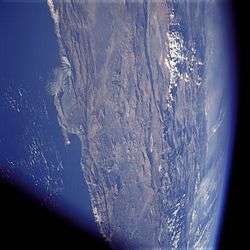Atacama Fault

The Atacama Fault Zone (AFZ) is an extensive system of faults cutting across the Chilean Coastal Cordillera in Northern Chile between the Andean Mountain range and the Pacific Ocean. The fault system is North-South striking and runs for more than 1100 km North and up to 50 km in width through the Andean Forearc Basin.[1] The zone is a direct result of the ongoing subduction of the Eastward moving Nazca Plate beneath the South American Plate and is believed to have formed in the Early Jurassic during the beginnings of the Andean orogeny. The zone can be split into 3 regions: the North, Central and South.
Tectonic history and formation
The AFZ has gone through periods of inactivity and reactivation since its inception in the Cretaceous.[2] The fault series was formed through a complex series of tectonic regimes dating back to the Early Jurassic.[3]
- The Andean back-arc basin separates from the Pacific Ocean in the Early Jurassic.[3]
- Intra-arc ductile deformation occurs, creating North-striking mylonitic shear zones in the late Jurassic.[3]
- Belt formed through a compressive regime in the early Cretaceous.[3]
- Compression of the Andean basement in the mid-Cretaceous.[3]
- Regime of extension from the Oligocene to Miocene.[3]
- Large brittle reactivations from the Miocene to Present.[3]
Regional geology
The fault zone penetrates the Chilean Coastal Cordillera through North-South striking elongate terranes of Jurassic to early Cretaceous igneous rocks.[2] The region was formed through arc-magmatism and is composed of mostly andesitic tuffs and lavas with large diorite batholiths.[2] Certain areas of these igneous provinces are overlain by terranes of continental clastic rocks and marine limestones.[2] Past and recent fault activity has reworked some of the surrounding rock, producing regions of ductilely deformed rocks, which can be categorized into two types:
- Metamorphic rocks from Jurassic volcanics, intrusive rocks (diorites, gabbros and tonalites), and Paleozoic greywackes formed in mid-amphibolite facies conditions.[2]
- Cretaceous plutonic rocks (tonalites) deformed under greenschist conditions.[2]
Fault mechanics
Due to the extensional regime shaping the region, the system is dominated by normal faulting, most of which is North-South striking and dipping around 60 degrees to the East.[3] Though the system is mostly dip-slip, there are regions of strike-slip formed mylonites in the East providing evidence for past sinistral strike-slip motion.[3]
The general strike of the fault system is North-South, though the fault activity varies between the 3 regions of the AFZ.
- Northern region: the Salar del Carmen major fault which splits the region into a Western domain with large active faults striking N160 to N170 and an Eastern domain with mostly inactive faults overlain by Quaternary deposits.[3]
- Central region: The Coastal Range is bounded by the N-S striking Remiendo Fault with ancient fault scarps in the eastern area of the region.[3]
- Southern region: The Coastal Range is bounded by the El Salado Fault, which trends North and is cutto the north by TalTal N130 striking faults.[3]
References
- ↑ Jensen, E.; Cembrano, J.; Faulkner, D.; Veloso, E.; Arancibia, G. (1996), "Development of a self-similar strike-slip duplex system in the Atacama Fault system, Chile", Journal of Structural Geology, 33 (11): 1611–1626, doi:10.1016/j.jsg.2011.09.002
- 1 2 3 4 5 6 Scheuber, E. (1990), "The kinematic and geodynamic significance of the Atacama Fault Zone, Northern Chile", Journal of Structural Geology, 12 (2): 243–257, doi:10.1016/0191-8141(90)90008-m
- 1 2 3 4 5 6 7 8 9 10 11 12 Chorowicz, J. (1996), "Neotectonic map of the Atacama Fault Zone (Chile) from SARS ERS-1 images", Third ISAG: 165–168
- Pia, V., et al. 2010, 'Monitoring seismic and silent faulting along the Atacama Fault System and its relation to the subduction zone seismic cycle: a creepmeter study in N-Chile', EGU general assembly, pg.4298.